

The Hybrid Teacher Survival Guide. Dr. W.'s Just for Fun toolbox. Dr. W.'s Essential toolbox. PD toolbox. Classroom Routines Must Change. Here's What Teaching Looks Like Under COVID-19. With less than a month before most schools in the country are scheduled to start, many teachers still don’t know how they will be conducting classes this fall.
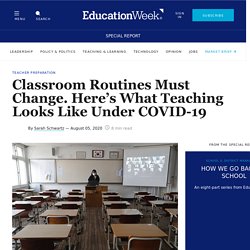
Each model brings its own challenges. Remote teachers will have to build class culture and routines with students they may never have met in person; teachers in school buildings will need to figure out how to adapt their instruction, shaped and constrained by the physical environment. In school buildings, almost every operational concern, from social-distancing-friendly class schedules to cleaning times, has implications for instruction. Some teachers may have to adapt courses from daily 45-minute periods to 90-minute blocks every other day; others will need to figure out how to plan small-group work so that it lines up with staggered bus arrivals. Class cultures built on collaboration or group project work will change.
For teachers, uncertainty can make it hard to prepare. The priority: Frequent, meaningful engagement. Lessons from the Field: Remote Learning Guidance - Distance Learning. Coronavirus (COVID-19) Main Web Page Distance Learning Main Web Page This information was formerly titled “Appendix2: Lessons from the Field: Remote Learning Guidance,” on March 17, 2020.
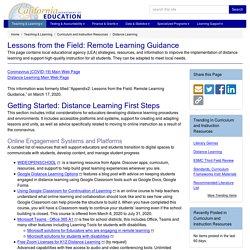
This section includes initial considerations for educators developing distance learning procedures and environments. It includes accessible platforms and systems, support for creating and adapting lessons and units, as well as advice specifically related to moving to online instruction as a result of the coronavirus. Online Engagement Systems and Platforms A curated list of resources that will support educators and students transition to digital spaces to communicate with students, develop content, and manage student progress.
Nurturing Teacher-Student Connections in a Virtual World. It took a set of costumes, funny voices, and made-up characters for Jamie Ewing, a K-5 science teacher at P.S. 277 in New York City, to settle into a groove with video lessons, and rekindle a connection with his students after instruction shifted wholesale to remote learning this spring.
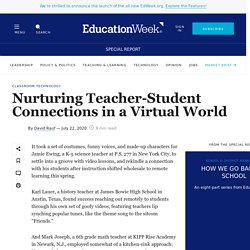
Karl Lauer, a history teacher at James Bowie High School in Austin, Texas, found success reaching out remotely to students through his own set of goofy videos, featuring teachers lip synching popular tunes, like the theme song to the sitcom “Friends.” And Mark Joseph, a 6th grade math teacher at KIPP Rise Academy in Newark, N.J., employed somewhat of a kitchen-sink approach: He pounded out more than 300 text messages a week to parents and students, harnessed an array of social media apps to “hype” his synchronous learning sessions, and held virtual movie nights and talent shows. They made home visits. They sent cards in the mail. They sang Happy Birthday through webcams. NCE Candid Conversation with Nicole Zumpano 4.15.20. Building Culture, Community, and Engagement toolbox. Distance Learning & Home School: Improving Parent-Teacher Communication.
Fostering good two-way communication with caregivers is vital for student success in a traditional classroom environment.
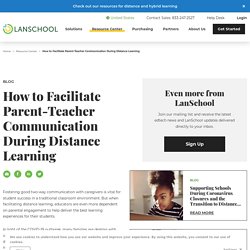
But when facilitating distance learning, educators are even more dependent on parental engagement to help deliver the best learning experiences for their students. In light of the COVID-19 outbreak, many families are dealing with unprecedented amounts of change. This change can be stressful as daily routines are interrupted, families and friends are isolated, and many caregivers attempt to balance working from home while their children learn from home. In some cases, the change to homeschooling has been even more difficult as families deal with grief over a lost loved one, job loss, and their own health concerns.
Ideas to Support Your Children at Home. Clear parent communication, support essential for remote learning success. Dive Brief: Nearly 50% of parents reported in a Canvas survey struggling to keep their child engaged in remote schoolwork this spring, and 30% said instructions from schools were unclear, according to an EdTech: Focus on K-12 article offering best practices for educators to support parents during remote learning.CDW-G analyst Curtiss Strietelmeier, a former superintendent and teacher, writes that schools should clearly document online learning plans and identify how students will be taught, list frequently asked questions, publish a list of important department contacts, and create tutorial videos to help parents and students understand ed tech tools.The article also suggests districts develop a plan for tackling IT requests, including prioritizing certain tasks and designating roles, and provide teachers with ed tech professional development so they can help parents troubleshoot minor tech issues during remote learning.
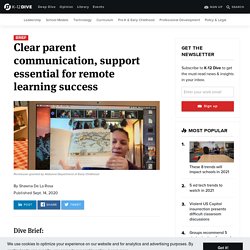
Dive Insight: ParentGuardian Communication. ESL_BE_teacher panel. Ten Strategies for Teaching English-Language Learners Online (Opinion) (This is the fourth post in a multipart series.
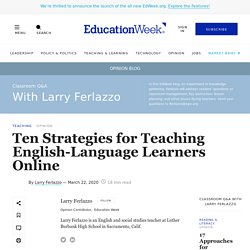
You can see Part One here, Part Two here, and Part Three here.) The new question of the week is: How can we best support students when we teach online? In Part One, David Sherrin, Lorie Barber, Janelle Henderson, and Cathleen Beachboard contributed their experiences. In Part Two, Amy Roediger, Dr. Helpful Online Resources for Teaching English Language Learners. Whether you’re having school remotely or in person, online learning is a powerful tool teachers can leverage to support English language learners (ELLs).
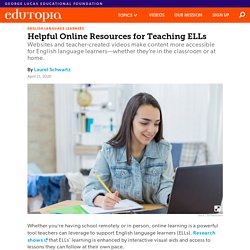
Research shows that ELLs’ learning is enhanced by interactive visual aids and access to lessons they can follow at their own pace. There are many free or inexpensive digital resources that teachers can use to create these learning experiences. Lessons can be recorded as they are conducted online in real time so that students can later access the content without a teacher present. Teachers can also incorporate audio, images, or videos into their lessons.
These resources can support ELLs with fun, engaging tools that help them review and build vocabulary and literacy skills. TeachersFirst: Adjusting Lessons for ESL/ELL Students. SPE_Teacher_Panel-Candid_Convo_webinar. Meg Schnoor webinar. 3 tips for teaching special education online. Sign up for our daily edtech news briefing today, free.

The rapid switch to remote learning this spring was a baptism-by-fire experience for our school district. We had to ramp up and get comfortable with technology seemingly overnight. It was pretty intense; teachers had to learn how to be “actors” on screen, with the right scripts, appearance, character, and delivery. Council for Exceptional Children. How Teachers Can Help Students With Special Needs… On day four of the second round of distance learning this fall, I saw something on my first-grade daughter’s Zoom meeting that broke my heart—both as a parent and as a school psychologist who supports students with special needs.

In a sea of happy little faces in a Brady Bunch–style gallery, I saw a white board with a message on it, propped up on a desk. I strained my eyes to see it, and it read: “I can’t learn like this. I have special needs.” The kid was nowhere in sight. Remote Learning for Littles. Supporting Young Children During Times of Isolation and Change. Connected Literacies Virtual Storybook Reading and Digital Writing During the COVID 19 Pandemic. Adapting for ELL toolbox. Adapting for Learners with Special Needs toolbox. Adapting for Littles toolbox. Teaching world languages in the virtual classroom. Sign up for ACTFL SmartBrief for stories about foreign-language instruction in your inbox.

Teachers of all content areas are likely to agree that virtual instruction is not ideal. In a communicative, dynamic world language class, teaching remotely seemed especially daunting. How do I ensure that my students are gaining proficiency in the language through a computer screen? After much contemplation and acceptance of the fact that virtual learning simply was not going to be the same as in the classroom, I knew that I needed to make the best of the situation for my students. I could not change the reality. I considered the four language domains: reading, writing, speaking and listening. Here’s what I did. Interpretive Tasks Giving my students opportunities to read in the target language is a constant goal of mine. I use Screencast-o-Matic to help develop listening comprehension skills. EdPuzzle is also good for creating listening comprehension tasks. Interpersonal Tasks Presentational Tasks.
How to Help Middle School Students Learn to Work Independently. We know that students are joining virtual classes in all kinds of different situations. Some students have their work-from-home parents closely monitoring their schoolwork. Other students are babysitting three cousins while their parents are at work. It can feel impossible to move at a pace that works for all students. So why not let them set their own pace?
Last school year, I rolled out a self-pacing model in my seventh-grade math class. Using Google Slides to Make Virtual Middle and High School Math Classes More Engaging. Many of us will be teaching remotely this fall due to the pandemic. How can we ensure that effective mathematics instruction and deep learning will still take place? Using Google Slides is a simple yet versatile way to teach mathematics remotely. Google automatically saves each slide deck, the toolbar is user-friendly, and the decks can be shared (and saved) by students. Giving students access to the slide deck by sharing an editor’s version of the deck link is a necessary first step toward student collaboration.
Last spring, I used Google Slide decks to engage my sixth and seventh graders in intriguing and enjoyable online lessons that coincided with the National Council of Teachers of Mathematics’ eight Standards for Mathematical Practice (SMP), which promote mathematical thinking, understanding, and application: SMP 1: Make sense of problems and persevere in solving them. Literacy: Have Fun at Home, Making Memories and Supporting Literacy. Reading and Writing Resources for Children at Home. Science toolbox. Math toolbox. ELA toolbox. The Many Uses of Exit Slips.
Grading During the Pandemic: A Conversation. Five Inconvenient Truths About How We Grade. 20 Ways to Cut Your Grading Time in Half. 7 Ways to Do Formative Assessments in Your Virtual Classroom. Pen-and-paper pop quizzes are no more: thumbs-up/thumbs-down, hand signals, online polls, discussion boards, and chat boxes have become the new mainstays of formative assessments in virtual classrooms. These quick pulse checks help teachers make sure that students are grasping key concepts—and identify holes in their understanding. “Good teachers in every subject will adjust their teaching based on what students know at each point,” says Vicki Davis, a director of instructional technology in Albany, Georgia, underscoring how crucial ongoing formative assessments are in the classroom.
Teachers don’t need to completely reinvent their traditional formative assessments, however, according to Mike Anderson, an educational consultant in Durham, New Hampshire. He recommends that teachers modify familiar practices—like exit tickets and think-pair-shares—so they work virtually. “In our distance learning environment, we run the risk of being further isolated. 1. 2. 3. 4. 5. 6. 7. Classroom Assessment Techniques (CATs) Print Version What Are CATs? Classroom Assessment Techniques (CATs) are generally simple, non-graded, anonymous, in-class activities designed to give you and your students useful feedback on the teaching-learning process as it is happening.
Examples of CATs include the following. The Background Knowledge Probe is a short, simple questionnaire given to students at the start of a course, or before the introduction of a new unit, lesson or topic. Delaying the Grade: How to Get Students to Read Feedback.
How K–12 Schools Monitor Attendance During Remote Learning. With the rapid transition to remote learning, it’s been a trying time for many school districts across the country. After all, they’ve had a lot to figure out — from finding ways to bridge the digital divide to ensuring student security and privacy online. Another major challenge is maintaining student attendance. When the novel coronavirus pushed schools to close their doors and adopt a remote learning model, many educators saw a drop in class attendance, according to Education Dive.
Thankfully, there are school districts that have found ways to tackle attendance during remote learning and conduct significant outreach to students and families who need it the most. MORE ON EDTECH: Learn how K–12 schools are bringing elective classes online. Tips to Track Student Attendance During Online Learning - Fedena Blog. Due to the recent COVID global pandemic, the usual methods of operating schools and colleges have changed. Blog.acadly. What does it mean to “attend” an online class? Assessment and Grading. Attendance. Asynchronous Learning: Definition, Benefits, and Example Activities. Asynchronous Learning is the key feature of successful online learning programs. What's the Difference Between Asynchronous and Synchronous Learning? Synchronous Learning vs. Asynchronous Learning. What’s the difference between synchronous learning and asynchronous learning? The answer could have a huge impact on your online education experience.
Remote Teaching: When and How to Use Synchronous vs. Asynchronous Methods. Synchronous Learning Toolbox. Asynchronous Learning Toolbox. Planning for eLearning toolbox. How to be a successful virtual teacher. With 87,000+ schools closing, the idea of school districts moving to a digital platform has become a reality. As a teacher, you’re probably feeling information overload. Not only has your normal day to day routine of teaching completely changed, the sheer amount of tools and information to go through can be staggering. Active Learning while Physically Distancing. 9 Skills That Make a Great Online School Teacher. Google Docs vous permet de créer et de modifier des documents en ligne gratuitement.
- Center for Learning and Teaching. 20 Best Practices and Expectations for Online Teaching: Technology for Teachers. 10 Best Practices To Be An Effective Online Teacher. The digital classroom brings with it a range of unknown and unexplored territory, mostly in part to its relative newness when compared to traditional teaching methods. To be an effective online teacher, there are 10 simple but effective practices you can follow. When coupled with a comprehensive course load and the right resources, there’s no reason why online learning can’t be even more effective than a traditional classroom setting. 1. Be Present. Principles of Effective Online Teaching - Great Plains IDEA. 10 Principles of Effective Online Teaching.
NLUteachervoices.